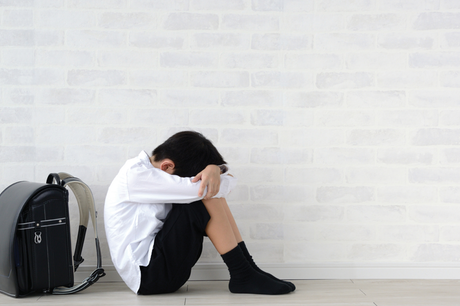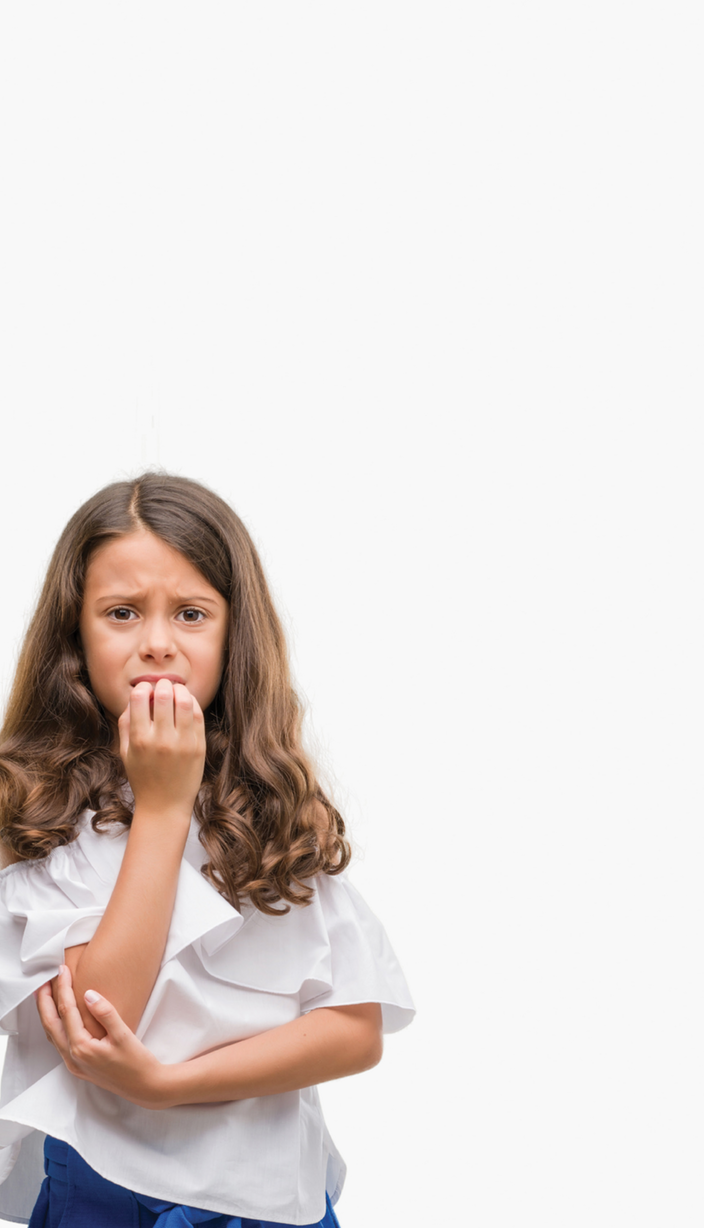Anxiety and students
What does anxiety look like and what can we do to minimise its impact on learning?

Anxiety is a prevalent mental health condition in Australia (Lawrence et al., 2015). On average, one in four people experiences anxiety at some stage in their life (Australian Bureau of Statistics, 2008). Student Wellbeing Officer Kathryn Harvey explains what the literature is telling us.
Anxiety disorders often present during adolescence (Lawrence et al., 2015). According to Kessler et al. (2005), the median age of onset for anxiety disorders is 11 years, which is before early adolescence. In Australia, one in 14 adolescents meets the diagnostic criteria for an anxiety disorder (Lawrence et al., 2015).
Intermittent and situational anxiety is normal and can occur prior to exams, public speaking, or when faced with a threat or danger. Anxiety can improve performance (Strack, Lopes, Esteves, & Fernandez-Berrocal, 2017), however, for some individuals, anxiety becomes excessive and significantly affects day to day living (Essau, Lewinsohn, Olaya, & Seeley, 2014).
According to the American Psychiatric Association (APA, 2013), anxiety is “an emotion characterised by feelings of tension, worried thoughts and physical changes like increased blood pressure”. The main features of anxiety include excessive fear and related psychosocial symptoms; for example, feelings of hopelessness or helplessness, panic, mood swings, despair, dissociation and flashbacks to a traumatic event (APA, 2013).
Disordered anxiety tends to be chronic, often interfering with life, such as impairing memory and concentration (Fernández Castillo & Caurcel, 2015). Anxiety symptoms can occur for no specific reason and can be challenging to manage (Hudson & McKinnon, 2017).
People with anxiety disorders may avoid certain situations, with many experiencing physical symptoms such as sweating, trembling, dizziness or a rapid heartbeat (Hudson & McKinnon, 2017). From a biological perspective, anxiety induces a heightened state of awareness to protect from threats. However, for those who are in a constant state of anxiety, their bodies never turn off the fight-flight response (Hudson & McKinnon, 2017).
Anxiety disorders are the result of a complicated interaction of biopsychosocial, genetic and situational factors (Hudson & McKinnon, 2017). A nearby threat is processed by different areas of the brain, through the amplification or the elimination of anxiety. When anxiety is amplified, brain areas can fail to function, causing irrational or inappropriate responses and behaviours (Hudson & McKinnon, 2017). A consequence of anxiety in adolescents and children is its negative impact long term.
Anxiety is linked to lower academic performance, poor social interactions and reduced school attendance, and its negative impacts may continue into adulthood (Erzen, 2017). If anxiety in an adolescent is left untreated, significant issues may occur later in life.
According to Olatunji, Cisler and Tolin (2007), anxiety disorders confer the greatest quality of life impairments in mental health and social functioning domains. Letcher, Sanson, Smart and Toumbourou (2012) state that anxiety disorders beginning early in life can be chronic, with a two-fold risk of recurrence in adulthood, and a significant risk of comorbidity with Major Depressive Disorder (Essau et al., 2014). In addition to psychiatric disorders in future adulthood, anxiety in adolescence also impacts other aspects of life.
Adolescent-onset anxiety can predict negative adjustment in work and life as well as diminished familial relationships, lower life satisfaction, ineffectual or inadequate coping skills and an increase in chronic stress (Essau at al.,2014). Furthermore, adolescent anxiety was predictive of substance abuse and/or dependence in adulthood, insomnia and reduced concentration (Essau et al., 2014; Hudson & McKinnon, 2017). Overall, anxiety can affect a person across several domains, including education.
Numerous studies conclude that anxiety negatively impairs academic achievements for adolescents (Muris & Meesters, 2002; Mychailyszyn, Mendez, & Kendall, 2010). Adolescents experiencing anxiety can have difficulty concentrating at school due to worrying thoughts (Wood, 2006). A study on parent and teacher responses undertaken by Mychaillyszyn et al. (2010) found that anxious adolescents reveal a higher level of academic impairment than non-anxious students. Anxiety in adolescents is associated with academic underachievement, higher school non-completion, avoidant behaviours and is the primary cause of school avoidance (Wood, 2006).
How does anxiety present in adolescents?
Anxiety often presents during adolescence, which means it is crucial for those working with the demographic to be vigilant. Adolescents may exhibit more behavioural manifestations of anxiety than the cognitive or conscious endorsement (more common in adult presentations).
In the classroom, the anxious student can often go unnoticed. The student may present as ‘shy’ or very quiet. In addition, the anxious student may present as defiant and disagreeable. These do not necessarily mean that the student is anxious, there may be other reasons behind their behaviours, but it is worth seeking advice for further assessment and or evaluations.
Top 10 signs of anxiety in students
1. Emotional changes
The anxious student may feel on edge, restless, uneasy or become defiant. The student may exhibit behaviours to avoid specific tasks or situations that they find threatening. For example, a student may misbehave before a test to get removed from the class, therefore avoiding the test. Other emotional change may include excessive worrying, low self-esteem, and overwhelming feelings.
2. Social changes
The social changes that the anxious student may present with include social withdrawal and isolation. Also, the student may, in a severe case of social anxiety, develop selective mutism.
3. Physical changes
Students feeling unwell is not a sign of anxiety, but when the student frequently presents to sick bay or requests to go home, it is essential to look for patterns in their presentations. Children and adolescents often present with the following signs of anxiety:
- frequent somatic complaints (including headaches, stomach aches, dizziness, nausea, vomiting)
- racing /pounding heart,
- sweating,
- trembling/shaking
- shortness of breath
- muscle tension
- panic attacks.
4. Sleep difficulties
The overall health and wellbeing of students is dependent on sleep. Anxiety is a frequent contributor to sleep issues. The anxious student can have trouble falling asleep, have nightmares and wake frequently.
5. Changes in school performance
School performance changes is a common indicator of anxiety. The anxious student may be absent often due to physical ailments, or have difficulty concentrating due to lack of sleep or worrying thoughts. Some of the signs that the student may be anxious include decrease in grades, frequently missed assessment tasks, the student feeling overwhelmed by the workload, procrastination and difficulties focusing on tasks.
6. Assuming the worst
When a student is anxious, they may assume the worst. For some students, focusing on negative thoughts is a way of preparing for a worst-case scenario, even if it is unlikely to happen. Negative thinking patterns can be challenging and frightening for the anxious student.
7. Perfectionism
Perfectionism occurs with anxiety for some students. The student’s anxiety levels increase as they are continually worrying about achieving high grades and not making mistakes. The perfectionist student can have low self-esteem and become obsessed with results and achievements.
8. Tantrums
Tantrums and defiance can be signs of an anxious student of any age. The student may be defiant towards teachers so that they can avoid a task, or they may become angry or distressed when being dropped at school. While not all students who are defiant or have tantrums have anxiety, it is crucial to investigate the cause of the behaviours as they could be an anxiety disorder.
9. School refusal
A common sign of anxiety is school refusal or school phobia. Students will go to excessive lengths to avoid going to school. The student may slowly disengage from their peers and extracurricular activities, miss classes or refuse to attend school completely.
10. Panic attacks
Panic attacks are a sign of anxiety. Some of the symptoms of a panic attack can include: the student’s behaviour changes, they become sweaty, dizzy, may begin to shake, have chest pain, breathing difficulties or experience derealisation or feel as if they are dying. If a student has a panic attack in the classroom, it is vital to be prepared and handle the situation gently and calmly so as not to escalate the student’s feelings. Speak calmly and reassuringly. The use of grounding and breathing techniques can reduce the severity. Teaching students mindfulness and incorporating it into classroom daily practices also provides support and prevention to all students.
The most effective way to support anxious students is to recognise the signs and understand that the student is unable to control their feelings easily. Many anxious students become confused, scared and overwhelmed by their emotions – and their anxiety only escalates.
Adolescent-onset anxiety can predict negative adjustment in work and life as well as diminished familial relationships, lower life satisfaction, ineffectual or inadequate coping skills and an increase in chronic stress.
As teachers, parents, carers and any person working with adolescents and children, it is vital to be non-judgemental, calm, reassuring and, most importantly, to listen. Talk to your students, tell them if you have noticed any changes and what you are concerned about. Let the students know you are there to support them.
Anxiety is challenging for the young person who experiences it. It can have serious long term effects, so if you are concerned, seek support from your school psychologist, counsellor or wellbeing person. With intervention, anxiety is manageable.
Author Kathryn Harvey is a Student Wellbeing Officer at Trinity College, Colac in Victoria. She is also a PhD student with Central Queensland University and sessional academic with the Australian College of Applied Psychology. Her previous research has focused on anxiety in rural primary to secondary school transition which was supported by the Jan Bavington Award grant from the Independent Education Union Victoria Tasmania.
References
American Psychiatric Association. (2013). Diagnostic and statistical manual of mental disorders (5th ed.). Arlington, VA.
Australian Bureau of Statistics, ABS. (2008, October 23). National survey of mental health and wellbeing: Summary of results, cat. no. 4326.0. Retrieved from:
https://www.abs.gov.au/ausstats/abs@.nsf/mf/4326.0
Essau, C. A., Lewinsohn, P. M., Olaya, B., & Seeley, J. R. (2014). Anxiety disorders in adolescents and psychosocial outcomes at age 30. Journal of Affective Disorders, 163, 125-132. doi:10.1016/j.jad.2013.12.033
Erzen, E. (2017). The effect of anxiety on student achievement. In E.Karadag (Ed), The factors affecting student achievement (pp.75-94). Switzerland: Springer International Publishing. doi: 10.1007/978-3-319-56083-0_5
Fernández Castillo, A. & Caurcel, M. J. (2015), State test anxiety, selective attention and concentration in university students. International Journal of Psychology, 50(4), 265-271. doi:10.1002/ijop.12092
Hudson, J., & McKinnon, A. (2017). Anxiety in young people. In R. Manocha (Ed.), Growing happy, healthy young minds (pp.53-63). Sydney Australia: Hachette.
Kessler, R. C., Berglund, P., Demler, O., Jin, R., Merikangas, K. R., & Walters, E. E. (2005). Lifetime prevalence and age-of-onset distributions of DSM-IV disorders in the National Comorbidity Survey Replication. Archives of General Psychiatry, 62(6), 593-602. doi: 10.1001/archpsyc.62.6.593
Lawrence, D., Johnson, S., Hafekost, J., Boterhoven de Haan, K., Sawyer, M., Ainley, J., & Zubrick, S.R. (2015). The mental health of children and adolescents: Report on the second Australian child and adolescent survey of mental health and wellbeing. Retrieved from
https://www1.health.gov.au/internet/main/publishing.nsf/Content/mental-pubs-m-child2
Letcher, P., Sanson, A., Smart, D., & Toumbourou, J. W. (2012). Precursors and correlates of anxiety trajectories from late childhood to late adolescence. Journal of Clinical Child & Adolescent Psychology, 41(4), 417-432. doi:10.1080/15374416.2012.680189
Muris, P., & Meesters, C. (2002). Symptoms of anxiety disorders and teacher-reported school functioning of normal children. Psychological Reports, 91(2), 588-590. doi:10.2466/pr0.2002.91.2.588
Mychailyszyn, M. P., Mendez, J. L., & Kendall, P. C. (2010). School functioning in youth with and without anxiety disorders: comparisons by diagnosis and comorbidity (Report). School Psychology Review, 39(1), 106. Retreived from:
https://www.researchgate.net/publication/279703860_School_Functioning_in_Youth_With_and_Without_Anxiety_Disorders_Comparisons_by_Diagnosis_and_Comorbidity
Olatunji, B.O., Cisler, J.M., & Tolin, D.F. (2007). Quality of life in the anxiety disorder: A meta-analytic review. Clinical Psychology Review 27(5),572-81. doi: 10.1016/j.cpr.2007.01.015
Strack, J., Lopes, P., Esteves, F., & Fernandez-Berrocal, P. (2017). Must we suffer to succeed?: When anxiety boosts motivation and performance. Journal of Individual Differences, 38(2), 113-124. doi:10.1027/1614-0001/a000228
Wood, J. (2006). Effect of anxiety reduction on children’s school performance and social adjustment. Developmental Psychology, 42(2), 345-349. doi:10.1037/0012-1649.42.2.345




































































































































